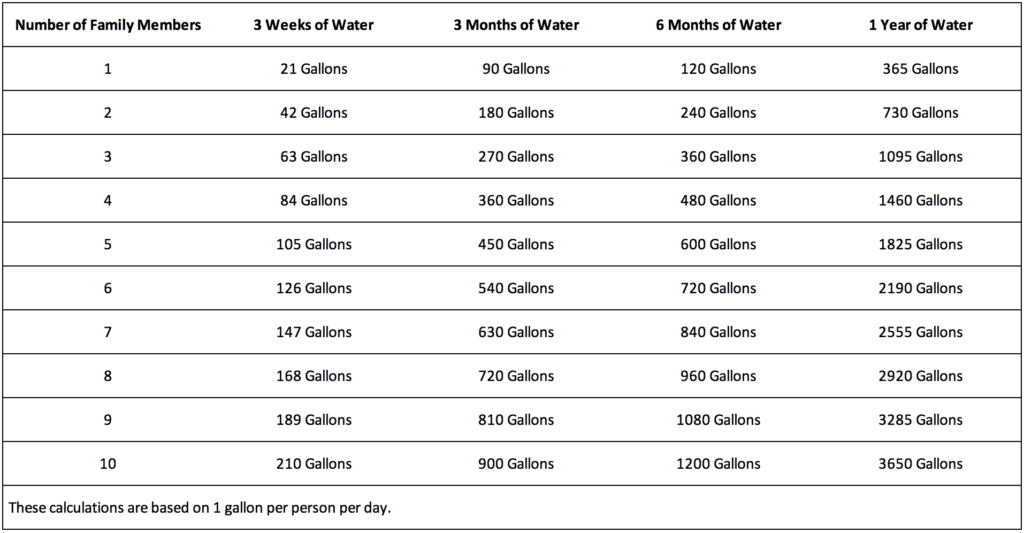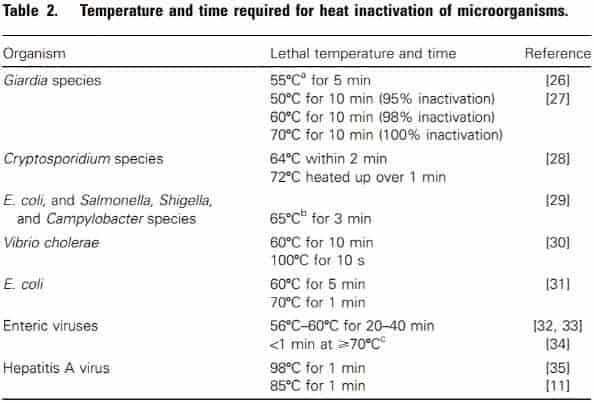Long-Term Water Storage Is Vital
Did you know that the human body is able to survive up to three weeks without food? Although that is hard to imagine, if (like most of us) you feel ravenous if you have a busy day and skip just one meal, our bodies have learned to adapt. This is only possible if you have sufficient water during these three weeks. Water is a different story. We are made up of 60% water, and although we may not consciously think about our thirst throughout the day in the same way we think about our hunger, we can literally only survive 72 hours without drinking. In other words: store water, always, for any emergency. To try to reduce the risk of not having access to drinking water, having an abundant supply of drinking water in your long-term storage is critical. The general recommendation for water storage is one gallon per person per day, to start. This chart breaks this down in a way to hopefully help you meet this goal, no matter your circumstances: But part of emergency preparation is anticipating every “what if” scenario. What if you run out of the water, or do not have access to water, or what if all the water around you is suddenly contaminated? The simple answer is, you boil whatever water you do have. This process will pasteurize the water so that it becomes safe to consume.
But part of emergency preparation is anticipating every “what if” scenario. What if you run out of the water, or do not have access to water, or what if all the water around you is suddenly contaminated? The simple answer is, you boil whatever water you do have. This process will pasteurize the water so that it becomes safe to consume.
READ MORE: How Do You Know If Water Is Safe To Drink In The Wild?
How Long Do You Have To Boil Water To Kill Bacteria?
In certain survival situations, you may find yourself stuck without safe water to drink. Perhaps you run out of water in your food storage, or the water gets contaminated. Perhaps you are stranded or lost in the woods with only small lakes and streams nearby. Perhaps there is a water crisis where all the tap water becomes unsterile. In these cases (and any others), a quick and simple option is to boil the contaminated water for 3 minutes. Although the specific amount of time to kill different bacteria may vary, boiling water for 3 minutes is a general and easy-to-remember rule that can potentially save your life by providing you with safe water to drink and cook with.But Does This Really Work?
Boiling water will pasteurize the water by raising it to 100 °C, or 212 ℉. When it reaches this temperature and the bubbles start to break on the surface, most of the bacteria, virus, and protozoa loses the structure of their protein make-up. Because of this, they are no longer able to hurt the human digestive tract.
How Effective Is Boiling Water For Water Purification?
Boiling water is effective for purification. Although the water won’t be completely sterile, the pathogens that could damage the digestive tract would be completely killed. This process is called pasteurization.
Is Boiling Water Enough To Kill Bacteria?
Yes. If the water you are disinfecting is a cloudy color, filter it first through a coffee filter or clean cloth before boiling. From here, boiling the water will be sufficient to kill the necessary bacteria so that it is safe to drink.
How Long Should You Boil Water To Kill 100 Percent Of Pathogens?
Not all bacteria are created equally, and different types of pathogens take different amounts of time to kill.
The chart below outlines which microorganisms are killed at which temperature and for which time period. As mentioned above, boiling water for 10 minutes in emergency situations is sufficient for killing all viruses and pathogens that would harm your digestive tract. Any remaining microorganisms would be safe to consume.

* Charles D. Ericsson, Robert Steffen, Howard Backer; Water Disinfection for International and Wilderness Travelers, Clinical Infectious Diseases, Volume 34, Issue 3, 1 February 2002, Pages 355–364, https://doi.org/10.1086/324747
Do I Need To Filter The Water Once The Bacteria Have Been Killed?
It depends. In most cases, the answer is no. That being said, if you get the water from a dirty lake, it might be preferable to filter it to get most of the bigger chunks out before you drink it.
After you have your water purified and filtered, you simply have to let it cool to room temperature, put it in airtight containers, and store it somewhere safe and cool.
READ MORE: How To Clean Plastic Barrels For Long-Term Water Storage

